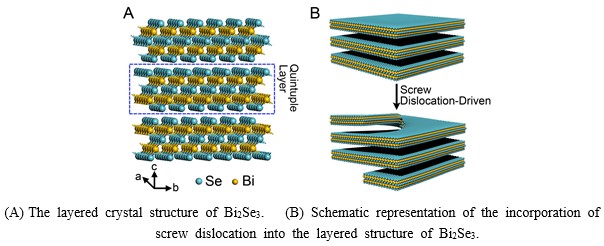Breakthrough in the Structural Design of Topological Insulator: Spiral Growth of Two-Dimensional Layered Material
The research group of Prof. Jie Zeng from School of Chemistry and Materials Science has made new progress in the controlled synthesis, structural design and growth mechanism study of two-dimensional (2D) layered topological insulator nanostructures. In their work, through manipulating kinetic parameters to induce screw dislocation-driven growth, Zeng and co-workers synthesized spiral bismuth selenide (Bi2Se3) nanoplates for the first time. The spiral growth could transform the layered structure of Bi2Se3 into a continuous spiral belt and thus create a drastically different type of material from the single-layer and bulk counterparts. The work has been published on Angew. Chem. Int. Ed. (DOI: 10.1002/anie.201403530) with the title of “Screw-Dislocation-Driven Bidirectional Spiral Growth of Bi2Se3 Nanoplates”.
Topological insulators are recently discovered as a new category of quantum materials, which have great potentials of application for dissipationless transport, spintronics, and quantum computing. Because of time-reversal symmetry, the surface states of topological insulators are protected against backscattering by defects or non-magnetic impurities. In addition, incorporating a line defect of screw dislocation into topological insulator material may create a pair of topologically protected one-dimensional (1D) helical states and thus a perfect conductive channel. Owing to the simple band structure and a band gap which is much larger than the room temperature energy scale, graphene-like 2D layered structure of Bi2Se3 has been proved to be a promising candidate for topological insulators. Based on previous works on the controlled synthesis of nanostructures and inspired by classical theories of crystal growth, Zeng’s group manipulated the reaction kinetics of the solution growth of Bi2Se3 and achieved very low supersaturation conditions that are advantageous to the generation of screw dislocations at the nucleation stage. Upon creation, these defects could serve as growth steps without an energy barrier. As a result, bidirectional spiral growth was realized and the thermodynamically preferred growth mode of Bi2Se3 was broken. Besides, through controlling the speed of spiral growth, they were able to obtain spiral nanoplates with preliminarily developed screw dislocations and to illuminate the spiral growth process. This work enriches the library of 2D layered nanostructures and offers a foundation for investigation of the 1D topologically protected helical states. The methods and results can be hopefully extended to other 2D layered materials and promote their design and applications. This work was supported by 973 Program, NSFC, Recruitment Program of Global Experts, CAS Hundred Talent Program, and Fundamental Research Funds for the Central Universities. 
Prof. Jie Zeng's website: http://zengnano.ustc.edu.cn/
Back
